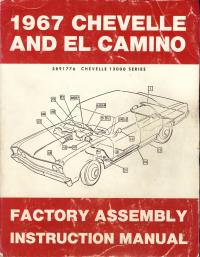Factory Assembly Instruction Manual

The various Factory Assembly Instruction Manuals (FAIM or AIM), I currently own 9 for 1964 through 1972 Chevelles and do not present author views or comments. Rather these are 'generic' non-technical drawings of assembly instructions for Chevelle final assembly. The drawings do not always indicate the correct year but part placement was the primary objective here, not the drawing's technical accuracies.
Pros:
As close as you can get to seeing how the car was suppose to be assembled on the Chevrolet final assembly line. Part numbers and revisions are included. Standard assemblies are listed as closely as applicable to the Uniform Parts Classification (UPC) groups the parts and assemblies belong. Regular Production Option (RPO) parts and assemblies are shown in alphabetical order by their RPO code designation when applicable.
Cons:
Since these deal with the final assembly at the various Chevelle assembly plants, no information is included from Fisher Body. This means many detail items on the body section itself, from the firewall back, are not included as these were installed by Fisher Body before being released to the "Body Bank" at the assembly plant. As such you won't find things like where to position trim pieces on the doors, quarter panels, or trunk/cove area of the body nor will you find anything about seat, interior trim, or glass installation. You will, however, find locations of trim pieces for the front fenders and hood as these panels as well as instrument panel items since these were installed on the final assembly line.
Part numbers do not include the Chevrolet group number but that is understandable since the assembly line worker didn't need that information. The drawings themselves are not engineer drawings in great detail but rather a generic sketch showing the location of the parts being described and may not show the surrounding parts as they actually appear. One example would be the RPO code G66 (air lift rear shock absorber-contents) page. A general outline of the body showing relative location of the parts to be assembled is shown as a 1966 Chevelle in the 1967 Chevelle AIM. Not really a problem as the focus is on the location of the various pieces and parts, not the body panels.
Recommendation:
Any of these is a must have book whether you are restoring your Chevelle to factory specifications or simply looking to see what parts are really for your year Chevelle and what parts are not. One must be aware that Chevrolet (GM) part numbers change quite often as it is determined that one part number can apply to more than one application with modifications applied to the part that does not compromise the serviceability of that part.

 Home
Home Decode
Decode Tech
Tech Tools
Tools Dale's Coins/CDs
Dale's Coins/CDs Contact
Contact Chevelle
of the Month
Chevelle
of the Month Things
For Sale
Things
For Sale Custom
Stickers
Custom
Stickers